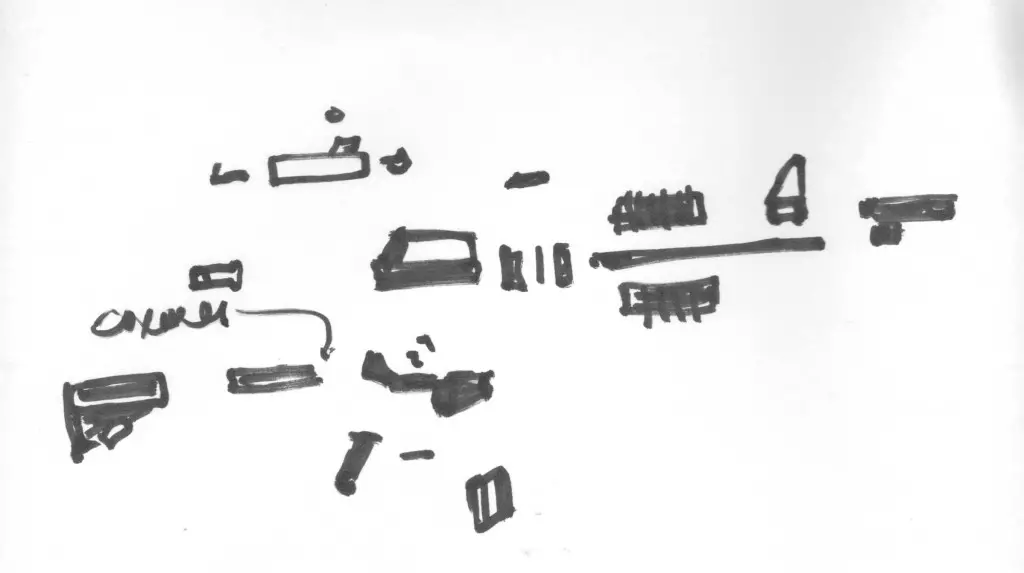The question arose: did we have everything we needed to proceed?
We knew the answer was no. We’re waiting on some parts to be delivered, including a backordered receiver from the premier maker of “retro” receivers, NoDak Spud LLC. They’re heavily backordered (we are waiting for several uppers, and multiple sets of “prototype” style AR parts). If we are still waiting too long, we’ll repurpose one of our currently deploted NDS receivers.
We were also waiting on some recent orders, including a gas tube from GunBroker, a barrel nut from Bravo Company, and several front sight base parts also from BCM. So we thought that it would make some sense to do an inventory.
Method 1: the rough sketch.
We made this rough sketch to show what we had and what we didn’t. It came in handy identifying some of the shortfalls in our stack of parts.
Yeah, this isn’t Michael Freaking Angelo. It’s a sketch, and a sketch done with a coarse point Sharpie at that. And it was worth doing, because it reminded us that we needed to get a carbine length gas tube, a barrel nut, and hit the parts box for an M16A1 vintage pistol grip.
That’s why you do the sketch. It’s also helpful in explaining where and when everything goes together.
Method 2: the interactive approach.
Before building your gun in meatworld you can sketch it out online, for example at Brownell’s AR15Builder.com. ARFCOM is also about to introduce one: their Gunstruction will be released from restricted- to public-beta status in September.
We have not participated in the Gunstruction beta, but have used Brownell’s configurator. It is limited to late-model parts; obviously, it’s biased towards things that Brownell’s sells.
Method 3: the inventory checklist.
Maybe you absorb the written word best. Heck, maybe you’re so uptight you have to have a written checklist to do anything. In that case, a checklist is for you. Brownell’s, again, has one that lets you account for all the parts you need for an AR build. Here’s the Brownell’s checklist; it even incorporates a tools checklist. We’re going to give this to the Building Kid so that he can start to internalize some of the terms we use.
A spreadsheet is simply a variant of the written checklist that exploits digital technology. Each has its place; a workshop may not be the best place for a computer, especially if machines are spewing cutting oil or tiny, conductive metal chips. But a paper document, unlike a digital one, can only be in one place at a time.
As you see, it’s possible to manage parts inventory with any of these methods. (And there are many more — whiteboards, toe tags, etc.). Just go with one of them, whichever one works best for you.
Short term and long term parts
We have more of some parts than we need, and that’s because we’re probably going to alter the living daylights out of this gun even after it’s built. We’re going to substitute a lot of “short term” parts temporarily for the real “long term” parts we want, but don’t have on hand. Then, as the fates (and the auctions) deliver up the right parts, we’ll swap the more correct ones in.
For example, the sketch shows two different flash suppressors. One is a long, replica moderator. The other, a short M16A1 cage. We consider the 16A1 cage a temporary part while we source a decent slip-over moderator.
We also, as we have noted, have substituted some parts. Because we’re using a 1960s Colt Model 604 upper receiver, which came from our parts rack, we’re using the matching 1960s chromed bolt and carrier assembly. This is not correct for any model of CAR-15; they all had parkerized bolts. We like the chrome for ease of cleaning, actually. (The Army ordered the change because it got some bad bolts where the plating had concealed flaws. Colt struggled with quality control amid trade-union troubles in the 1960s).
As we previously discussed, we are using a later barrel, specifically a Daniel Defense lightweight barrel, which promises more reliability with M4 feed ramps, and better accuracy with later, heavier bullets.
We also are waiting for the “correct” vinyl-acetate dipped aluminum Colt stock. In the meantime, the parts box offers us a Colt military fiberlite stock and a Bushmaster commercial-spec aluminum one. The Bushmaster looks more correct than the later-vintage 1980s Colt part, but the Bushy buffer tube is “commercial” spec and won’t fit a “correct” stock when we go to install it.

Kevin was a former Special Forces weapons man (MOS 18B, before the 18 series, 11B with Skill Qualification Indicator of S). His focus was on weapons: their history, effects and employment. He started WeaponsMan.com in 2011 and operated it until he passed away in 2017. His work is being preserved here at the request of his family.


2 thoughts on “Let’s Build Retro: Part 3: Parts Inventory”
If you don’t already have it, Tapco makes a commercial diameter extension that’s the correct length and has a squared off end for your Bushy stock. Most new commercial extensions are about an inch too long and have an angled rear that matches the angle of the later M4 style stock.
Thanks for the tip, Mac. Both the Colt fiberlite and the Bushy aluminum come with the period two-hole, flat-back extensions. The vinyl acetate stock coming in is without an extension. I have a gage for the extensions, it’s easier than micing them.
One excellent score, thanks to a guy in the old unit, was the actual stock from my rifle in Afghanistan. They got upgraded stocks and binned the old ones. The guns still have the extensions they came with 15-20 years ago (they were pre-SOPMOD, full-auto M4s that have been upgraded repeatedly).